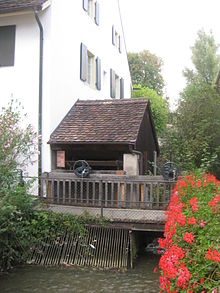St. Alban's pond

The St. Alban pond , called Dalbedych in the Basel dialect , is a 4.75 km long commercial canal that was built in the High Middle Ages between Münchenstein (in the Birseck area ) (Canton of Basel-Landschaft ) and Basel (Canton of Basel-Stadt ) in Switzerland .
Until the 19th century, the St. Alban-Teich Canal secured a large part of Basel's energy supply thanks to the use of hydropower . The cultural and historical significance of the canal results from its connection with paper production and the printing works of Basel, whose technical maturity made the city a center of humanism at the end of the 15th and the beginning of the 16th century .
course
The water of the St. Alban-Teich canal was originally derived from St. Jakob an der Birs from a tributary of the Birs that still existed around 1100 . In the years 1624/25 the canal was extended upstream through the Brüglinger Plain and the Münchensteiner district “ Neue Welt ” to the “Birswehr” (“Birswasserfall”). There the Birswasser is branched off from the Birs - near the A18 motorway a little northeast of the "Wasserhausstrasse" in Münchenstein ( ⊙ ).
The St. Alban-Teich flows northwards in two arms ("St. Alban-Teich" and "Mühle-Teich") through Brüglingen . Like the canal, the two ponds that it feeds are artificially created, but much more recent. It is the «St. Alban-See ”and the“ Quellsee ”, both created in 1980 on the site of the Swiss horticultural exhibition Grün 80 (today“ Stiftung Park im Grünen ”). The two arms reunite at St. Jakob an der Birs.
At the historic Basel city limits at the St. Alban-Tor , the St. Alban-Teich divides again: the "Hintere Teich" and the "Vordere Teich" lead partly open, partly covered through the Basel-St. Alban ( called Dalbeloch in the dialect ). Both finally flow between the Wettstein Bridge in the west and the Black Forest Bridge in the east, directly west of the jetty of the anchorage «St. Alban-valley "( ⊙ ) in the Rhine .
General
The St. Alban-Teich canal was artificially created in the 12th century by the St. Alban Monastery in Basel to operate flour mills. The “corporation for the use of the St. Alban pond”, founded in 1336, has sole right of disposal over all water to this day; the building itself is publicly owned by the community of Basel (as the legal successor to the St. Alban Monastery, which was dissolved by the Reformation). «Statute and water regulations» of June 12, 1964 regulate the legal situation at St. Alban-Teich. The most important members of the corporation are the canton of Basel-Stadt , the municipality of Basel and the Christoph Merian Foundation . Information boards about its history have been set up along the canal since 2004.
use
The St. Alban pond is a commercial canal, as the more than a dozen water mills built along it used to serve various trades and industries (especially paper manufacture - later silk ribbon manufacture, wood, metal and grain processing ) (the usable water power is over 800 kW calculated); In addition, tree trunks were loosened on it (also for the production of shingles ) from the Jura to Basel. During the Basel Council (1431–1448), high-quality paper production was set up for the intensive correspondence and correspondence with ten existing mills at St. Alban-Teich, which the book printing industry, which was occupied in Basel from 1468 at the latest, could continue to use. The combination of paper production and excellent print shops (especially the Amerbach and Johann Froben families ) resulted in many important publications on humanism ( Ship of Fools , Praise of Folly , Erasmus Bible ) appearing in Basel; The Erasmus of Rotterdam taking up residence in Basel is also justified by this technologically initiated circumstance.
Today hydropower only drives the mill of the Swiss Museum for Paper, Writing and Printing in St. Albantal and, for demonstration purposes, the grain mill of the “Mühlemuseum Brüglingen ”, but since 1998 a newly built small hydropower plant has also been producing at the pond inlet in the “Neue Welt” district »Enough electricity for the annual consumption of around 1,000 households. The canal was also used by the cantonal fisheries inspectorate for years as a rearing water for young salmon. In accordance with its commercial use, the St. Alban pond is not designed as a habitat. It has a high degree of construction, lack of bank areas, monotonous flow conditions and numerous indentations. Significantly, not all of the animal species native to the Birs are found in the St. Alban pond. Since its reopening in 2006, the well in St. Jakob an der Birs has also been using the water power of the St. Alban pond for its pumping system as a historical demonstration object.
literature
- Schweizer, Eduard: The fiefs and trades at St. Albanteich. In: Basler Zeitschrift für Geschichte und Altertumskunde , Vol. 21 and 22 (1923 and 1924) ( digitized part 1 ; digitized part 2 )
- Golder, Eduard: St. Albanteich, the history of a commercial canal. Basel 1986.
